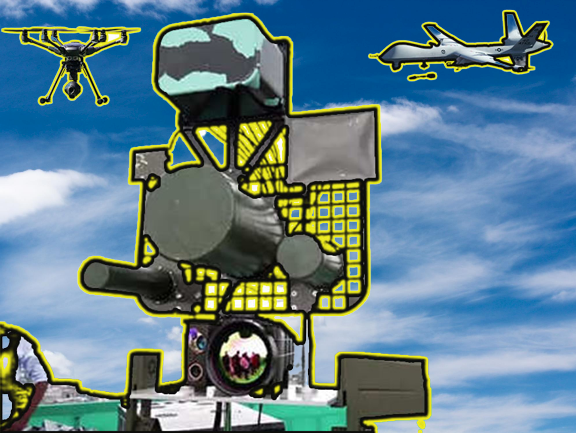
- Anti-drone systems employ a variety of techniques and technologies, including detection, identification, tracking, and neutralising enemy drones if necessary.
- India is actively exploring and deploying various anti-drone systems like the D4S, developed by DRDO and manufactured by BEL.
- Anti-drone systems not only enhance security but also protect the privacy, safety, and well-being of individuals and communities.
Anti-drone systems, also known as counter-drone or counter-UAS (Unmanned Aircraft Systems) systems, serve as critical technologies designed to detect, track, identify, and mitigate the risks associated with unauthorized or potentially malicious drones. These innovative systems play a pivotal role in protecting essential infrastructure, public gatherings, military facilities, and other sensitive locations from potential drone misuse.
Anti-drone systems employ a variety of techniques and technologies to fulfil their objectives, including detection, identification, tracking, and the option to neutralize drones if necessary. The demand for countermeasures against both armed and unarmed drones has surged due to the increasing global threat posed by drones for several key reasons:
1. Accessibility: Drones have become more accessible to the general public, with affordable consumer-grade models available, rendering them vulnerable to misuse.
2. Ease of Use: Modern drones are designed to be user-friendly, enabling individuals with minimal training to operate them effectively.
3. Versatility: Drones come in diverse types and sizes, some equipped with advanced cameras or capable of carrying payloads, including weapons or surveillance equipment, making them adaptable for various purposes, both lawful and unlawful.
4. Stealth: Drones can operate quietly and at low altitudes, making them difficult to detect using conventional radar systems, allowing them to approach targets discreetly.
5. Range: Drones can cover substantial distances, potentially reaching remote or sensitive areas, and posing threats to crucial infrastructure and military installations.
6. Payload Delivery: Some drones can transport hazardous payloads, such as explosives or harmful materials, raising concerns about their potential utilization in acts of terrorism or sabotage.
7. Surveillance and Espionage: Drones equipped with cameras and sensors can be employed for unauthorized surveillance or espionage, compromising privacy and security.
8. Criminal Activities: Drones have been utilized in various criminal activities, including drug smuggling.
Given India’s vulnerable borders, a shared boundary of 3,323 kilometres with Pakistan, there have been significant incidents of cross-border smuggling of weapons and drugs. To counter these aerial threats, India is actively exploring and deploying various anti-drone systems. One notable system is the Drone Detect, Deter, and Destroy system (D4S), developed by DRDO and manufactured by Bharat Electronics Limited (BEL).
The D4S system boasts the capability to detect and neutralize multiple drones within a radius of approximately 4 kilometres through jamming technology. It utilizes a combination of radars, radio frequency detection systems, electro-optic sensors, and other techniques for drone detection, identification, and countermeasures, including both non-destructive and destructive options.
Furthermore, the Indian Navy has engaged with the Israeli company Smart Shooter to acquire fire control systems, including the SMASH 200 Plus, designed to eliminate drone threats. This system incorporates day and night modes, a drone-specific kill mode, and an integrated fire control computer, enhancing the effectiveness of security forces.
In summary, the proliferation of drones has introduced new challenges and security concerns, both in India and globally. As these unmanned aircraft become more accessible and versatile, the importance of robust countermeasures has never been more apparent.
Anti-drone systems like the Drone Detect, Deter, and Destroy system (D4S) and the SMASH 200 Plus represent state-of-the-art solutions developed to safeguard essential infrastructure, public events, military installations, and vulnerable border regions. These systems harness advanced technologies, including radar, radio frequency detection, electro-optic sensors, and jamming capabilities, to efficiently detect, identify, and neutralize unauthorized drones.
While these technologies offer a promising defence against drone threats, it’s crucial to acknowledge that the ongoing cat-and-mouse game between drone operators and countermeasure systems will likely evolve further. Future developments may involve even more sophisticated drones and countermeasures, underscoring the continued necessity for research, innovation, and collaboration between governments and technology companies.
Ultimately, the deployment of anti-drone systems signifies a proactive approach to addressing the multifaceted challenges posed by drones. These systems not only enhance security but also protect the privacy, safety, and well-being of individuals and communities. As technology advances, so too will our ability to safeguard against emerging threats from the skies, ensuring a safer and more secure future.
(The author is a post-graduate student in International Relations at Kalinga University, Raipur. The opinions expressed are the author’s own)
Aayush Pal is a freelance writer on contemporary geopolitical developments. The views expressed in his work are entirely his own.
